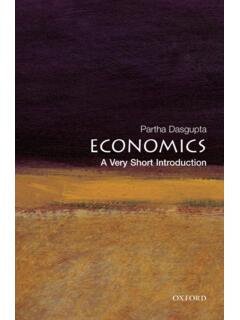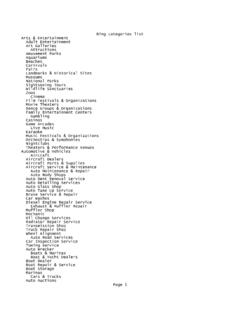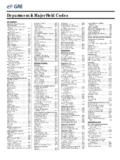Transcription of Manias, Panics, and Crashes - Grasping Reality by Brad DeLong
1 FM JWBK120/Kindleberger February 13, 2008 14:53 Char Count=Manias, Panics, andCrashesA History of Financial CrisesFifth EditionCharles P. KindlebergerandRobert Z. AliberJohn Wiley & Sons, JWBK120/Kindleberger February 13, 2008 14:53 Char Count=iiFM JWBK120/Kindleberger February 13, 2008 14:53 Char Count=Manias, Panics, and CrashesFifth EditioniFM JWBK120/Kindleberger February 13, 2008 14:53 Char Count=iiFM JWBK120/Kindleberger February 13, 2008 14:53 Char Count=Manias, Panics, andCrashesA History of Financial CrisesFifth EditionCharles P. KindlebergerandRobert Z. AliberJohn Wiley & Sons, JWBK120/Kindleberger February 13, 2008 14:53 Char Count=C 2005 by Charles P. Kindleberger and Robert Z. Aliber; 1978, 1989, 1996, 2000by Charles P. rights copyright by Robert M. SolowPublished by John Wiley & Sons, Inc., Hoboken, New JerseyPublished simultaneously in CanadaNo part of this publication may be reproduced, stored in a retrieval system, ortransmitted in any form or by any means, electronic, mechanical, photocopying,recording, scanning, or otherwise, except as permitted under Section 107 or 108 of the1976 United States Copyright Act, without either the prior written permission of thePublisher, or authorization through payment of the appropriate per-copy fee to theCopyright Clearance Center, 222 Rosewood Drive, Danvers, MA 01923, 978-750-8400,fax 978-646-8600, or on the web at Requests to the Publisher forpermission should be addressed to the Permissions Department, John Wiley & Sons, Inc.
2 ,111 River Street, Hoboken, NJ 07030, 201-748-6011, fax of Liability/Disclaimer of Warranty: While the publisher and the author have usedtheir best efforts in preparing this book, they make no representations or warranties withrespect to the accuracy or completeness of the contents of this book and specificallydisclaim any implied warranties of merchantability or fitness for a particular purpose. Nowarranty may be created or extended by sales representatives or written sales advice and strategies contained herein may not be suitable for your situation. Youshould consult with a professional where appropriate. Neither the publisher nor theauthor shall be liable for any loss of profit or any other commercial damages, includingbut not limited to special, incidental, consequential, or other general information about our other products and services, please contact ourCustomer Care Department within the United States at 800-762-2974, outside theUnited States at 317-572-3993 or fax also publishes its books in a variety of electronic formats.
3 Some content thatappears in print may not be available in electronic books. For more information aboutWiley products, visit our website at of Congress Cataloging-in-Publication Data:Kindleberger, Charles Poor, 1910 2003 Manias, panics, and Crashes : a history of financial crises / Charles P. Kindleberger. 5th 978-0-471-46714-4 (pbk.)1. Financial crises. 2. Business cycles. 3. Depressions. I. 42 dc222005001066109876ivFM JWBK120/Kindleberger February 13, 2008 14:53 Char Count=ContentsForeword by Robert M. Solowvii1 Financial Crisis: A Hardy Perennial12 Anatomy of a Typical Crisis243 Speculative Manias384 Fueling the Flames: The Expansion of Credit645 The Critical Stage906 Euphoria and Economic Booms1137 International Contagion1238 Bubble Contagion: Tokyo to Bangkok to New York1429 Frauds, Swindles, and the Credit Cycle16510 Policy Responses: Letting It Burn Out, and Other Devices20311 The Domestic Lender of Last Resort22512 The International Lender of Last Resort24313 The Lessons of History and the Most TumultuousDecades Ever275 Appendix294 Notes304 Index340vFM JWBK120/Kindleberger February 13, 2008 14:53 Char Count=viFM JWBK120/Kindleberger February 13, 2008 14:53 Char Count=ForewordCharlie Kindleberger (CPK from now on) was a delightful colleague:perceptive, responsive, curious about everything, full of character, and,above all, lively.
4 Those same qualities are everywhere evident inManias,Panics, and think that CPK began to work on the book in the spirit of writ-ing a natural history, rather as Darwin must have done at the stage oftheBeagle collecting, examining and classifying interesting , panics, and Crashes had the advantage over rodents, birds, andbeetles that they were accompanied by the rhetoric of contemporaries,sometimes with insight, sometimes just blather. It was CPK s style as aneconomic historian to hunt for interesting things to learn, not to pursuea systematic course, he was an economist by training and experience, andhe soon found patterns and regularities, and causes and effects. Whatcaught his eye especially were the irrationalities that seemed so often toenmesh those directly or indirectly enmeshed in the events itself that would have been merely entertaining. The story got in-teresting for CPK with the interaction of behavior and institutions. Theoccurrence of manias, panics, and Crashes , and their ultimate scope, alsodepended very much on the monetary and capital-market institutionsof the could not have known at the start just how hardy a perennialfinancial crisis would turn out to be.
5 The quarter-centuryafterthe pub-lication of the first edition featured a whole new level of turbulence innational banking systems, exchange-rate volatility and asset-price bub-bles. There was always new material to be digested in successive history cannot have been merely the result of increasing human ir-rationality, though CPK would have been charmed by what a Germanfriend of ours called Das Gesetz der Verschlechtigung aller Dinge (theLaw of the Deterioration of Everything). Increasing wealth, faster andcheaper communication, and the evolution of national and interna-tional financial systems also played an indispensable role, as sketchedin Chapter 13, added to this edition by Robert Aliber. CPK s effort ateconomic history found a subject that does not appear to be going outof JWBK120/Kindleberger February 13, 2008 14:53 Char Count=viiiForewordThe shape of a new financial architecture and the possible utility ofa lender of last resort national and/or international along with theguidelines that ought to govern it were also among CPK s preoccupa-tions.
6 Those who are engaged in reforming (or at least changing) thesystem would do well to ponder the lessons that emerge from this of those lessons is very general, and is most applicable in contextswhere irrationality may trump sober calculation. CPK was a skeptic bynature, just the opposite of doctrinaire. He mistrusted iron-clad intel-lectual systems, whether their proponents were free marketeers or socialengineers. In fact, he considered clinging to rigid beliefs in the face ofdisconcerting evidence to be one of the more dangerous forms of irra-tionality, especially when it is practiced by those in charge. The interna-tional economy would be a safer place if CPK s tolerant skepticism weremore common among the powers that be. I am thinking, in particular,about current discussions of the so-called Washington consensus, andthe pros and cons of both freely floating exchange rates and unfetteredcapital reader of this book will come away with the distinct notion thatlarge quantities of liquid capital sloshing around the world should raisethe possibility that they will overflow the container.
7 One issue omittedin the book because it is well outside its scope is the other side ofthe ledger: What are the social benefits of free capital flow in its variousforms, the analogue of gains from trade? CPK, whose specialties as aneconomist included international trade, international finance and eco-nomic development, would have been sensitive to the need for somepragmatic balancing of risks and benefits. One can only hope that thecontinued, up-to-date availability of this book will help to spread hisopen-minded habit of seems to me that the Aliber version preserves this basic Kindlebergerorientation but imposes a little more order on CPK s occasionally way-ward path through his specimen cabinets. More manias, panics, andcrashes may plague us, but readers of this book will at least have SOLOWc01 JWBK120/Kindleberger February 13, 2008 14:58 Char Count=1 Financial Crisis: A Hardy PerennialThe years since the early 1970s are unprecedented in terms of the volatil-ity in the prices of commodities, currencies, real estate and stocks, andthe frequency and severity of financial crises.
8 In the second half of the1980s, Japan experienced a massive bubble in its real estate and in itsstock markets. During the same period the prices of real estate and ofstocks in Finland, Norway, and Sweden increased even more rapidly thanin Japan. In the early 1990s, there was a surge in real estate prices andstock prices in Thailand, Malaysia, Indonesia, and most of the nearbyAsian countries; in 1993, stock prices increased by about 100 percentin each of these countries. In the second half of the 1990s, the UnitedStates experienced a bubble in the stock market; there was a mania inthe prices of the stocks of firms in the new industries like informationtechnology and the always implode; by definition a bubble involves a non-sustainable pattern of price changes or cash flows. The implosion ofthe asset price bubble in Japan led to the massive failure of a large num-ber of banks and other types of financial firms and more than a decadeof sluggish economic growth.
9 The implosion of the asset price bubblein Thailand triggered the contagion effect and led to sharp declines instock prices throughout the region. The exception to this pattern is thatthe implosion of the bubble in stock prices in 2000 led to declinesin stock prices for the next several years but the ensuing recession in2001 was brief and changes in the foreign exchange values of national currenciesduring this period were often extremely large. At the beginning of the1970s, the dominant market view was that the foreign exchange value ofthe dollar might decline by 10 to 12 percent to compensate for the1c01 JWBK120/Kindleberger February 13, 2008 14:58 Char Count=2 Manias, Panics, and Crasheshigher inflation rate in the United States than in Germany and in Japanin the previous few years. In 1971 the United States abandoned the parity of$35 an ounce that had been established in 1934; in thenext several years there were two modest increases in the gold parityalthough the Treasury would no longer buy and sell gold.
10 The effortto retain a modified version of the Bretton Woods system of peggedexchange rates that was formalized in the Smithsonian Agreement of1972 failed and there was a move to floating exchange rates early in1973; in the 1970s the dollar lost more than half of its value relativeto the German mark and the Japanese yen. The dollar appreciatedsignificantly in the first half of the 1980s, although not to the levels ofthe early 1970s. A massive foreign exchange crisis involved the Mexicanpeso, the Brazilian cruzeiro, the Argentinean peso, and the currencies ofmany of the other developing countries in the early 1980s. The Finnishmarkka, the Swedish krona, the British pound, the italian lira, and theSpanish peseta were devalued in the last six months of 1992; most ofthese currencies depreciated by 30 percent relative to the German Mexican peso lost more than half of its value in terms of the during the presidential transition in Mexico at the end of 1994and the beginning of 1995.







